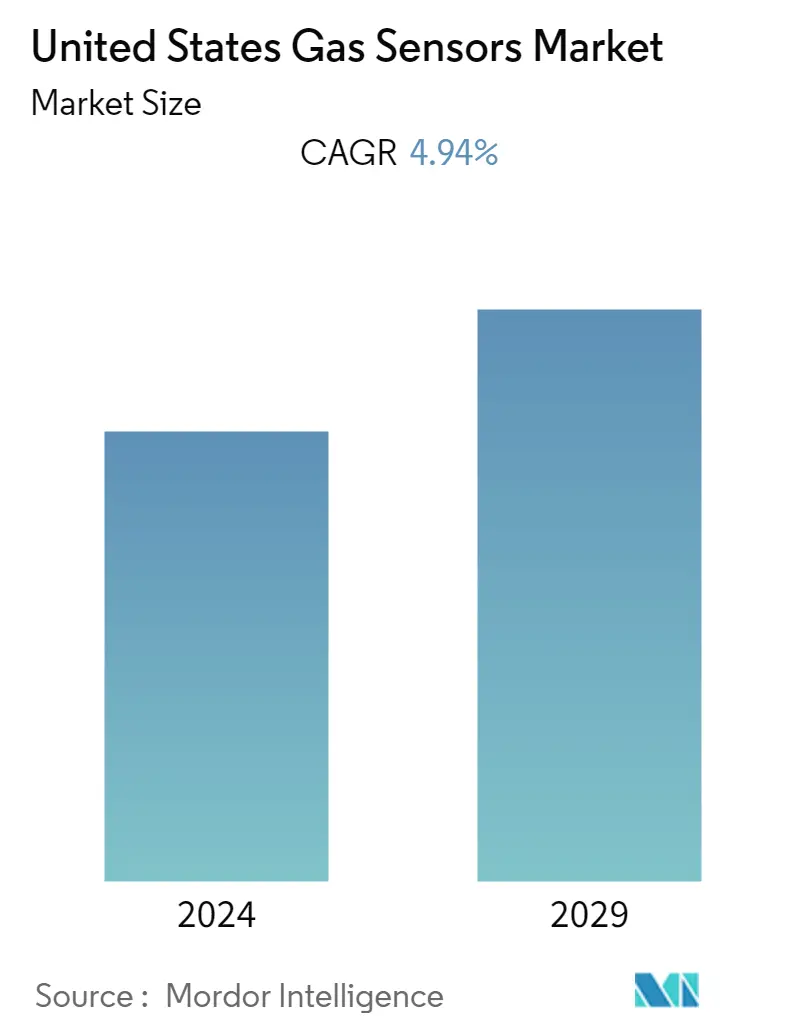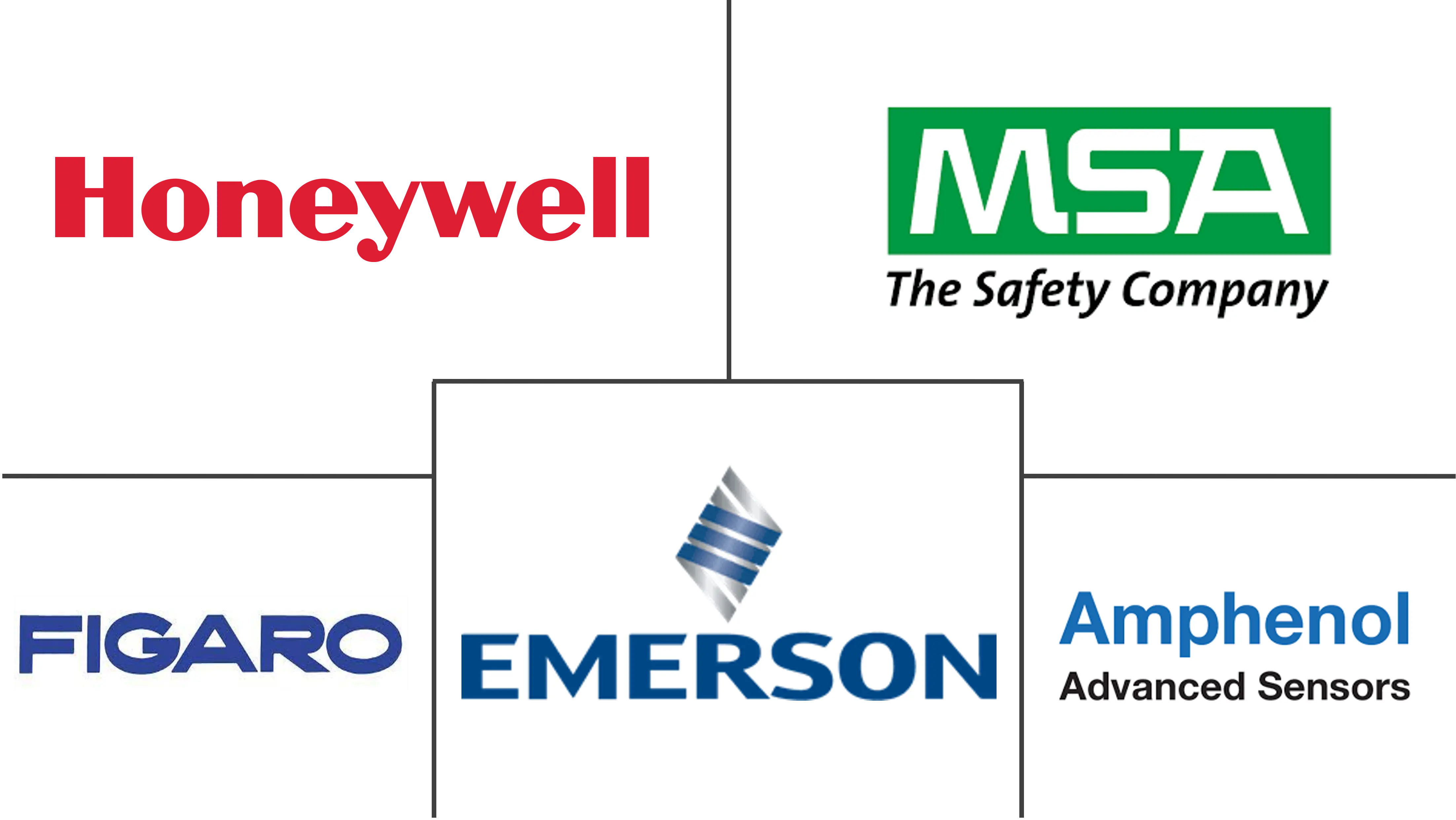Market Size of United States Gas Sensors Industry

| Study Period | 2019 - 2029 |
| Base Year For Estimation | 2023 |
| Forecast Data Period | 2024 - 2029 |
| Historical Data Period | 2019 - 2022 |
| CAGR | 4.94 % |
| Market Concentration | Medium |
Major Players
*Disclaimer: Major Players sorted in no particular order |
Need a report that reflects how COVID-19 has impacted this market and its growth?
US Gas Sensors Market Analysis
The US gas sensors market is expected to register a CAGR of 4.94% over the forecast period. Gas sensors are generally utilized in environmental monitoring, alcohol breath analyzer tests, fire location, process control industries, the discovery of unsafe gases in mines, home health, and reviewing of agro-items, such as espresso and flavor. These sensors adopt different techniques for quantifying a medium's exact amount of gas. The COVID-19 pandemic impacted the market due to disruptions in the operations of particular end-user businesses that rely heavily on gas sensors.
- The major trend driving the gas sensors market is the development of wireless capabilities and miniaturization, coupled with improved communication capabilities that enable their integration into various devices and machines without compromising the detection of toxic or flammable gases at safe distances.
- Gas sensors are used in smart cities for various environmental monitoring applications like monitoring air quality across weather stations, public places, small cities, and building automation. Such widespread use is anticipated to boost the market's growth over the forecast period. Heating, ventilation, and air conditioning (HVAC) systems are utilized in buildings for various functions, such as environmental monitoring and regulating the concentration of a gaseous component, which has generated a significant amount of demand and is anticipated to propel the market's growth.
- Regarding energy usage, IoT-ready sensors based on batteries can run for extended periods, primarily in outdoor conditions. It would be preferable for gas sensors to continue operating until the transducer's lifetime expires. Mixing energy sources, including solar panels, would be feasible to replenish the batteries. Some gas sensing technologies use less energy since the transducers do not require temperature correction and can be turned off between measurement intervals, such as acoustic and optical approaches. Other technologies, including electrochemical, MOS, and catalytic, have a pre-heating time. Therefore, turning off these transducers would severely impact their performance and ability to produce accurate measurement readings.
- Another critical factor in sensing technologies is connectivity. More users emphasize their ability to successfully read and gather data through standard analog or digital outputs, cloud connectivity, or wireless monitoring. Customers can obtain critical readings and updates from a compatible smartphone or PC remotely monitoring gas concentrations in real time. Users interested in cloud-based tracking and data logging often select the Aranet4 PRO Indoor Air Quality Monitor - a sleek, modern, wireless-enabled gadget capable of precisely detecting CO2, relative humidity, temperature, and barometric pressure via the Aranet4 iOS or Android app.
- Wireless gas sensors offer several advantages, such as accuracy and reliability, with the help of various innovative technologies, such as RFID and Bluetooth, and the potential to make electronic devices easy to integrate. As a result, they gained significant traction in the past few years. Wireless technology is primarily deployed for IoT applications, allowing direct connection over Wi-Fi, 3G or 4G mobile data networks, or local wireless networks. Many wireless devices consist of built-in intelligence that automatically identifies and links to the wireless building network by pushing a button that adds the device to the network.
- The US government is at the forefront of the fight against climate change. The country has a strong record of advancing technologies and techniques to reduce greenhouse gas emissions as part of this fight. According to the United States Environmental Protection Agency (EPA), in the United States, the oil and gas industry is the largest industrial source of methane emissions, which emits more methane than the total emissions of all greenhouse gases from 164 countries combined. Oil and natural operations also emit toxic air pollutants such as benzene and smog-forming volatile organic compounds (VOCs).
- In November 2021, the US government launched an initiative to reduce emissions from the oil and gas industry significantly. Through actions, the United States is catalyzing similar efforts worldwide, working in partnership with the European Union to lead a Global Methane Pledge to reduce overall methane emissions by 30% below 2020 levels by 2030.
- Researchers are implementing advanced technologies for designing to manufacture gas sensors in response to many new and emerging requirements and applications. Some of the research sectors include wearable gas sensors, energy-harvesting gas sensors, and gas sensors in mobile phones.
- During the pandemic, gas sensor firms have developed new products to maintain the cash flow. For instance, AerNos, Inc. intends to highlight its nano gas sensor technologies and capabilities targeted at the Smart Home market. For applications involving the monitoring of dangerous gases and indoor air quality, AerNos is introducing embeddable solutions with ground-breaking gas-sensing capabilities. Applications for the Smart Home gas sensor module from AerNosinclude automated air purification in HVAC, ventilation, and intelligent air purification systems and providing consumer air quality warnings from Smart Home products.
